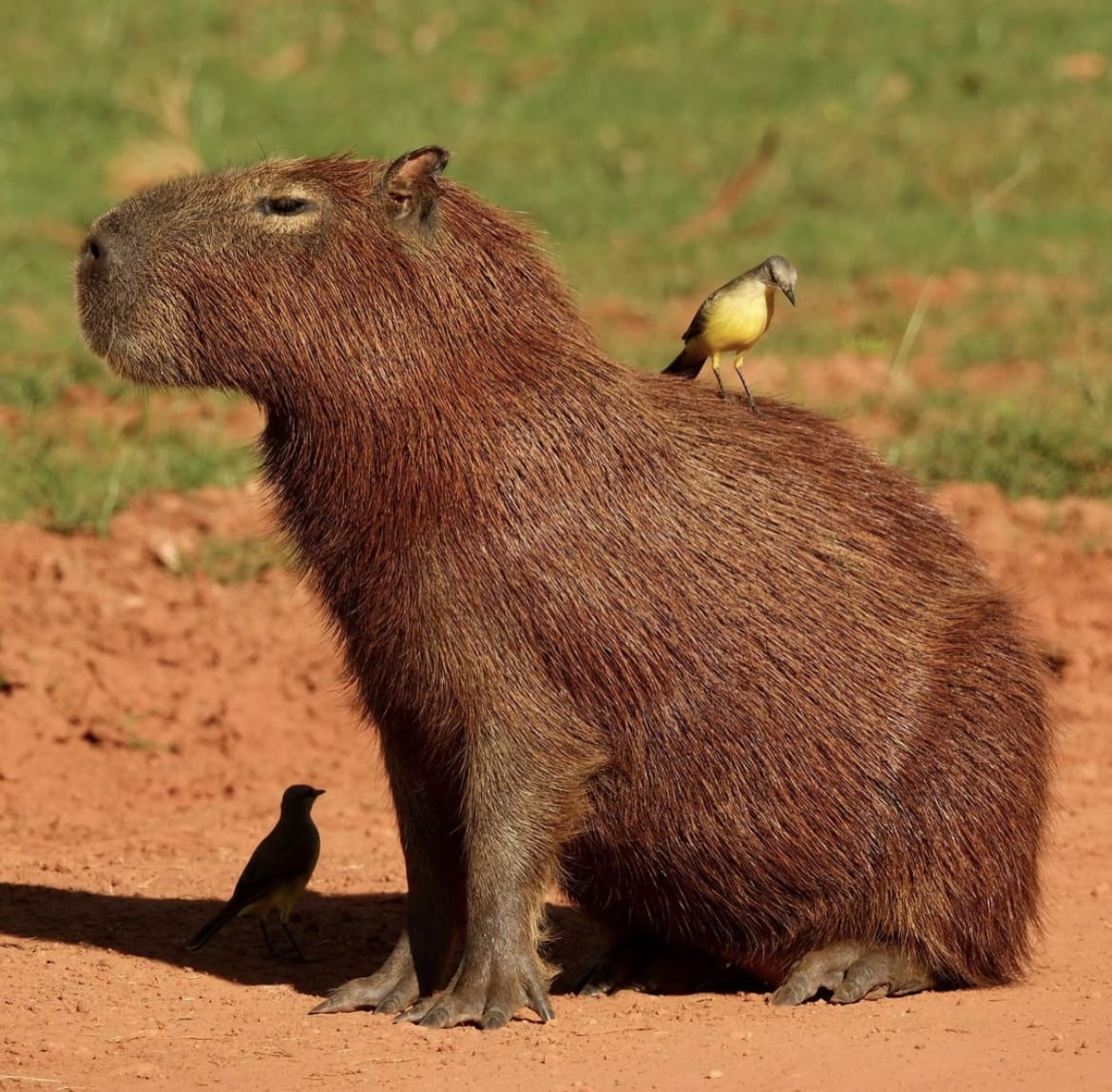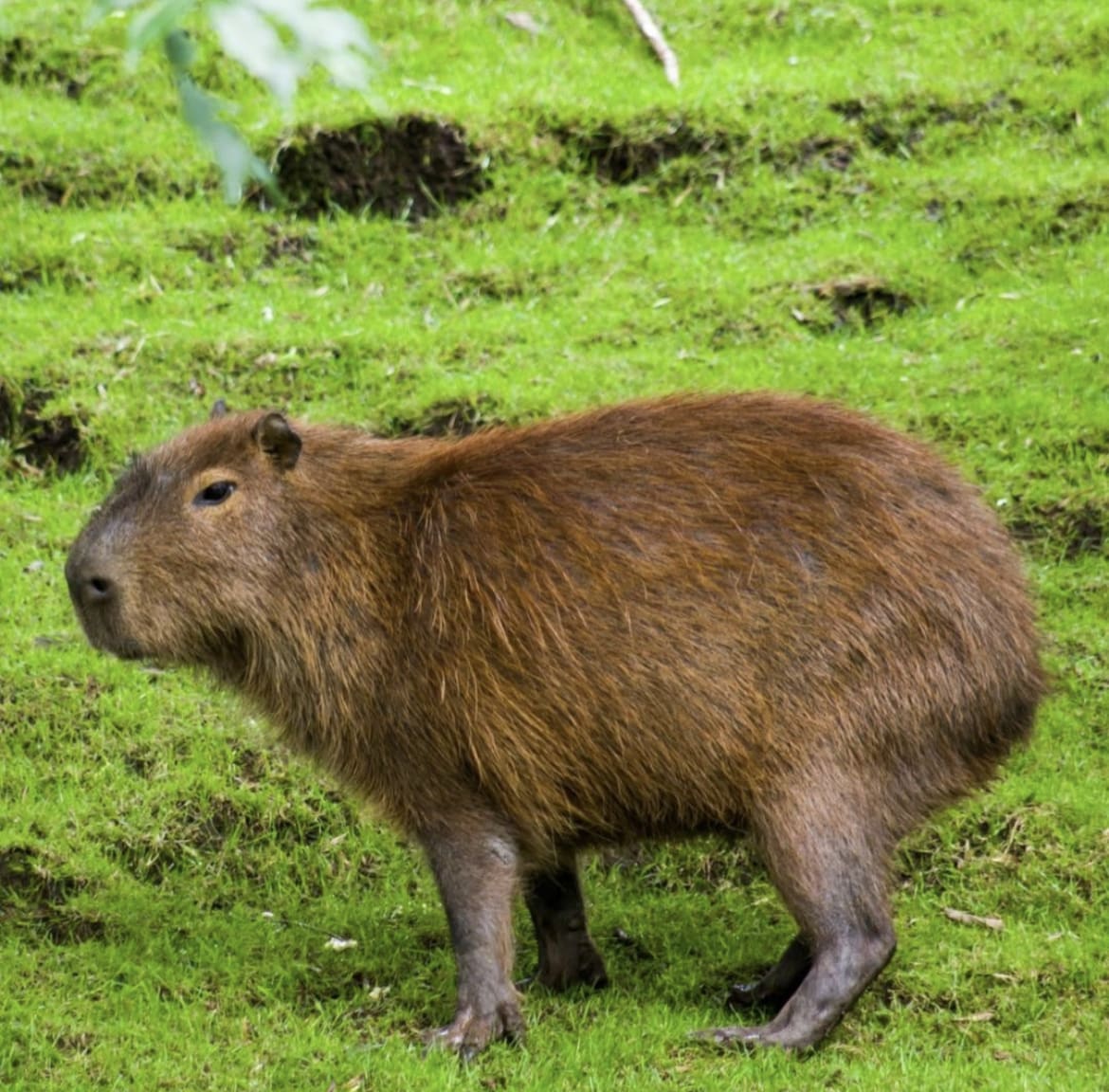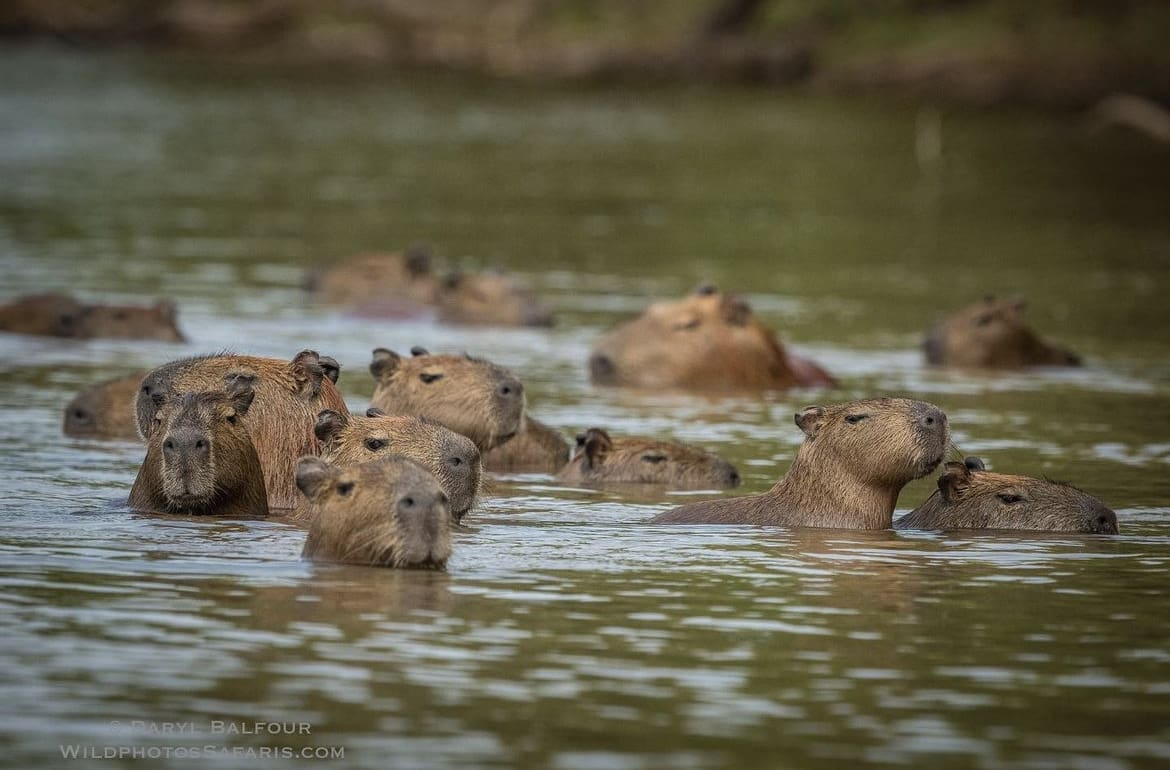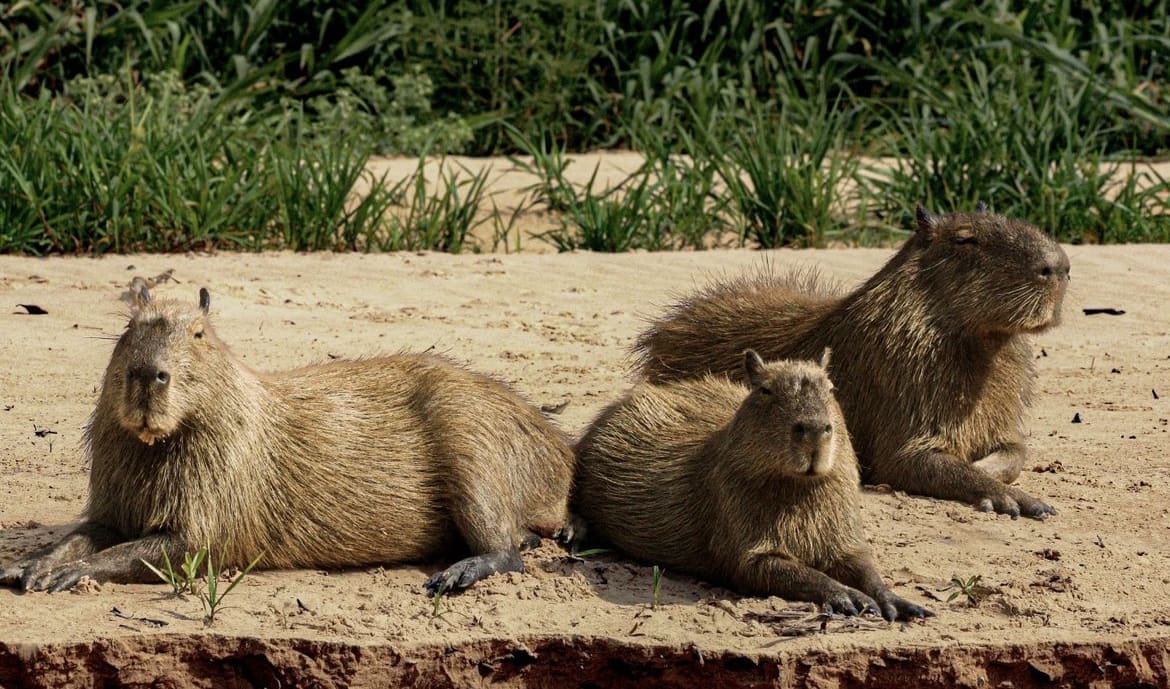Ever heard of a capybara? No? Imagine a guinea pig. Got it? Now, blow it up to the size of a large dog, and you’re in the right ballpark. These creatures are not your average pet store rodents; they’re the largest of their kind in the world.
So, let’s dive into the world of these oversized, semi-aquatic chill masters.
What is the Capybara
The capybara, or Hydrochoerus hydrochaeris for the science geeks among us, is basically the kingpin of the rodent world. Native to South America, these guys love to hang out in groups along riverbanks, lakes, and marshes. They’ve got a rep for being incredibly social and laid-back. Plus, they play a crucial role in their ecosystem, acting as nature’s lawnmowers by chowing down on grass and helping control vegetation growth.
Capybaras are a testament to nature’s creativity. They’ve adapted perfectly to life both in and out of water, with nifty features that help them thrive in their wetland homes. And let’s not forget, they’ve been around the block, historically speaking, mingling with humans for centuries, featuring prominently in South American folklore and even modern social media.

What do Capybaras Look Like?
A capybara is like the ultimate blend of several animals you know. They’ve got the chunky body of a beaver, minus the tail, and the face of a guinea pig, if it decided to go on a serious gym routine. Adult capybaras sport a sleek, short fur coat that’s perfect for their love of swimming. Their fur is dense and coarse, designed to dry quickly after a leisurely swim.
One of the capybara’s signature parts is its webbed feet. Yep, you heard right – webbed, like a duck’s, which makes them fantastic swimmers. They can even dive and stay underwater for up to five minutes to hide from predators or just to cool off on a hot day. So, if you’re envisioning a furry, friendly torpedo gliding through the water, you’re not far off.
How Big are Capybaras?
When we say big, we mean the-biggest-rodent-you’ve-ever-seen kind of big. An adult capybara can weigh as much as a small human, clocking in at anywhere from 77 to 146 pounds (35 to 66 kilograms). And they’re not just heavyweights; they’re also pretty tall – standing about 20 to 24 inches (50 to 62 centimeters) at the shoulder. That’s about knee-high to an average adult human.
Their size isn’t just for show; it helps them navigate their environment, from pushing through dense vegetation to swimming strong currents. Plus, their hefty build makes them less of a target for predators. I mean, would you want to mess with a rodent the size of a bulldog?
Capybara Skin
Capybara skin is not just any skin; it’s specially adapted to their love for water. Their skin secretes a greasy substance that helps waterproof their fur, making them the Michael Phelps of the rodent world. This oily coating is crucial for their semi-aquatic lifestyle, keeping them dry and cozy while they’re submerged.
And, fun fact: this substance has a sweet, musky odor that’s quite distinctive. So, if you’re ever near a capybara and catch a whiff of something… unique, now you know why.
Capybara Legs
Capybaras have relatively short but sturdy limbs, equipped with those webbed feet we mentioned earlier. These adaptations make them excellent swimmers and even better sprinters on land. Their legs are designed for life on the move, allowing them to traverse the varied terrain of their habitats with ease.
Whether it’s paddling through water or galloping on land (yes, they can gallop), their legs support their active lifestyle. It’s all about balance for these creatures, blending their aquatic and terrestrial sides perfectly.

Capybara Colouration
Capybaras come in a chic shade of brownish-gray, which is not just a fashion statement but a survival tactic. This color helps them blend into their natural surroundings, providing camouflage from predators.
Depending on the region they inhabit, their fur can range from dark brown to almost a yellowish hue. This variation helps them adapt to different environments, from the lush, green wetlands to the more arid areas of their range.
So, while they might not win any beauty contests in the traditional sense, their coloration is a badge of their adaptability and resilience.
What do Capybaras Eat?
Capybaras are the vegans of the animal kingdom, with a strict herbivorous diet that’s all about greens. These guys munch on a smorgasbord of grasses, aquatic plants, fruits, and even bark when they’re feeling adventurous. Their menu changes with the seasons, showing their flexible palate and ability to adapt to what’s available. They’re particularly fond of water plants, which is handy since they spend so much time in and around water sources.
Their eating habits are not just about filling their bellies; they play a crucial role in maintaining the health of their habitats. By chomping down on vegetation, they help control plant growth and ensure ecosystems remain balanced. It’s nature’s way of lawn mowing, with capybaras as the gardeners.
Capybara Social Structure
If there’s one thing to know about capybaras, it’s that they’re incredibly social creatures. They live in groups that can range from a cozy 10 to a bustling 100, depending on the space and resources available. These groups, often a mix of families, provide safety in numbers and help in the rearing of young ones.
The capybara social scene is all about hierarchy, with a dominant male leading the group and several females and their young making up the rest. But it’s not all about power; these social structures ensure the group’s survival, facilitating everything from foraging to predator evasion. Plus, they’re known for their peaceful nature, with social bonding activities like grooming playing a big part in maintaining group harmony.
It’s like a constant hangout with their best buds, proving that capybaras might just be the most chill socialites in the animal kingdom.

How do Capybaras Reproduce?
When it comes to love, capybaras are pretty straightforward. Their breeding season is usually tied to the rainy season, when water and food are abundant. After a gestation period of about 130 to 150 days, a female can give birth to a litter of 1 to 8 pups, though the average is around 4.
These pups are born pretty advanced, with fur, open eyes, and the ability to run around within hours of birth. They’re also incredibly social from the get-go, integrating into the group almost immediately. This rapid development is crucial for their survival in the wild, where dangers lurk around every corner.
Parental care is a group effort, with other females in the group often helping to nurse and protect the young. It’s a testament to the capybara’s strong social bonds and collective approach to raising their young.
How Long do Capybaras Live?
Capybaras have a relatively modest lifespan, particularly when you consider their size and social complexity. In the wild, these creatures typically live around 8 to 10 years, though this can vary based on factors like predation, habitat conditions, and food availability.
In captivity, where threats are minimized, and healthcare is available, they can live longer, with some reaching up to 12 years or more. Their lifespan reflects the challenges they face in their natural environments, from evading predators to competing for resources.
Are Capybaras Aggressive?
Despite their imposing size, capybaras are known for their docile and even-tempered nature. They’re not ones to pick a fight or show aggression unnecessarily. However, like any wild animal, they can become defensive if they feel threatened or cornered, especially when protecting their young. The dominant male in a group may also show aggression towards rival males during mating season, but these instances are more about posturing and establishing dominance than actual combat.
Their peaceful demeanor is one of the reasons capybaras have become popular subjects in viral videos and social media posts, often seen lounging with not only their own kind but a variety of other animals as well. Their ability to coexist peacefully with other species, including humans, is a testament to their laid-back approach to life.

Are Capybaras Territorial?
Capybaras exhibit a fascinating blend of territorial and communal living. While they live in groups that share resources and space cooperatively, they also establish and defend territories within their habitat. These territories are primarily centered around water sources, which are crucial for their survival. The dominant male plays a significant role in marking and defending this territory, using scent marking from glands located on his nose.
However, their territorial behavior doesn’t equate to exclusivity. Capybara groups have been known to overlap territories with others, sharing access to vital resources, especially during the dry season when water and food become scarce. This balance between defending their space and sharing resources highlights their adaptability and the complex social structures that govern their communities.
Where do Capybaras Live?
Capybaras are the globetrotters of South America’s wetlands, thriving in a variety of aquatic environments across the continent. From the lush, dense vegetation along the Amazon River to the vast, grassy plains of the Pantanal, capybaras adapt to their surroundings like pros. They favor areas with abundant water sources, such as rivers, lakes, swamps, and marshes, which are essential for their semi-aquatic lifestyle. These habitats not only provide them with the necessary resources for their diet but also offer protection from predators.
Their ability to inhabit a wide range of environments speaks to their adaptability and the critical role they play in maintaining the ecological balance of their ecosystems. By grazing on grasses and aquatic plants, they help prevent overgrowth and support the biodiversity of their habitats.
How Many Capybaras are There in the Wild?
Quantifying the exact number of capybaras in the wild is a challenging task due to their widespread distribution and the varying conditions of their habitats across South America. However, they are considered one of the more populous large mammals on the continent. Their numbers are generally stable in areas where their habitats are preserved and protected, but in places where human activity encroaches on their environment, their populations can face pressure.
Environmental changes, such as deforestation and the conversion of wetlands to agricultural land, pose significant threats to capybara habitats, potentially impacting their numbers. Despite these challenges, capybaras have shown resilience, thanks in part to their ability to adapt to different environments and their relatively high reproductive rate.

Are Capybaras Endangered?
Currently, capybaras are not classified as endangered; they are listed as a species of “Least Concern” by the International Union for Conservation of Nature (IUCN). This status reflects their wide distribution and relatively stable population sizes in areas free from severe human-induced habitat destruction.
However, this doesn’t mean they’re out of the woods. The stability of capybara populations heavily depends on the conservation of their natural habitats and the sustainable management of their ecosystems. Issues such as illegal hunting for their meat and skin, along with habitat loss due to agricultural expansion, continue to pose threats. Conservation efforts are crucial to ensure that capybaras remain a common sight in South America’s waterways and not just a footnote in ecological studies.
Threats to Capybaras in the Wild
Despite their adaptability and widespread presence across South America, capybaras face several significant threats that could impact their future survival. One of the primary challenges is habitat destruction caused by deforestation and the expansion of agriculture and urban areas. Such changes not only reduce the areas where capybaras can live but also fragment their habitats, making it harder for them to find food, water, and mates.
In addition to habitat loss, capybaras are hunted for their meat and hide, particularly in rural areas. While hunting is regulated in some countries, illegal poaching still occurs and can significantly affect local populations. Furthermore, as capybaras are often found near water sources, pollution and changes in water management, such as dam construction, can also adversely affect their habitats and food sources.

Where to See Capybaras
For those eager to see these remarkable animals in their natural environment, there are several spots across South America where capybaras are commonly found. The Pantanal, the world’s largest tropical wetland area spread across Brazil, Bolivia, and Paraguay, is one of the best places to observe capybaras in the wild. This vast, open habitat provides ample opportunities to see them grazing or lounging by the water.
Other notable locations include the Esteros del Iberá in Argentina, one of the largest freshwater wetlands in the world, and the Los Llanos grasslands stretching across Venezuela and Colombia. National parks and nature reserves in these areas often offer guided tours that increase your chances of spotting capybaras, making them a must-visit for wildlife enthusiasts.
Tips for Spotting Capybaras
Spotting capybaras can be a thrilling experience, but it requires patience and a bit of know-how. Here are some tips to increase your chances:
- Visit during the early morning or late afternoon: Capybaras are most active during these cooler parts of the day when they come out to feed and bathe.
- Stay near water: Capybaras are semi-aquatic and spend a lot of time in and around water bodies. Rivers, lakes, and wetlands are your best bet for finding them.
- Move quietly and patiently: These animals are generally not shy, but loud noises can startle them. Move slowly, keep noise to a minimum, and be patient.
- Look for groups: Capybaras are social animals, so where there’s one, there are likely more. Spotting a group is easier than finding a solitary individual.
- Use binoculars: To avoid disturbing their natural behavior, maintain a respectful distance. Binoculars can help you get a closer look without getting too close.

Facts about The Capybara
- Incredible Swimmers: Capybaras can stay submerged underwater for up to 5 minutes to hide from predators.
- Social Creatures: They live in groups that can number up to 100 individuals, especially near plentiful food sources.
- Communication: Capybaras communicate using a variety of sounds ranging from barks to whistles, depending on the situation.
Myths about The Capybara
- Giant Rats: While they are rodents, capybaras are far more docile and sociable than the common perception of rats.
- Loners: Contrary to the myth that large rodents are solitary, capybaras are incredibly social and depend on their groups for survival.
- Aggressive by Nature: Despite their size, capybaras are generally peaceful and only show aggression when threatened.
